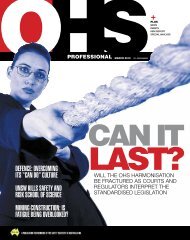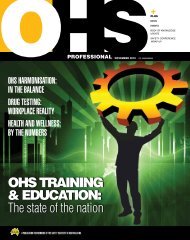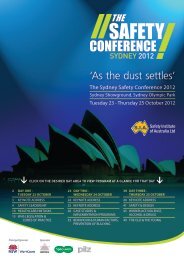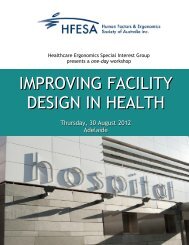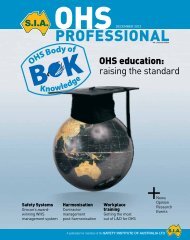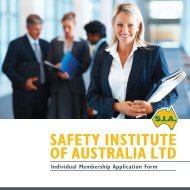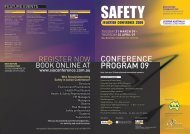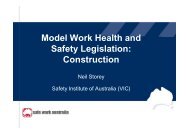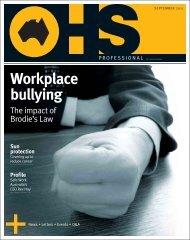In-service safety inspection and testing of electrical equipment
In-service safety inspection and testing of electrical equipment
In-service safety inspection and testing of electrical equipment
You also want an ePaper? Increase the reach of your titles
YUMPU automatically turns print PDFs into web optimized ePapers that Google loves.
flexible cord <strong>and</strong> a cord extension socket,NOTE — An example <strong>of</strong> a cord extension set is shown in Appendix F, figure F2.1.4.8 Electric portable outlet device (Power boards <strong>and</strong> EPODs)A device, other than a cord set, or cord extension set having a single means <strong>of</strong> connection to a lowvoltage supply, <strong>and</strong> one or more outlet facilities. It may incorporate a reeling or coiling arrangement.1.4.9 Fixed <strong>equipment</strong>Equipment which is fastened to a support, secured in position or otherwise, due to its size <strong>and</strong> mass,located in a specific location.1.4.10 HireNOTE — Adhesives are not recognized as a means <strong>of</strong> fastening fixed <strong>equipment</strong> to a support unlessspecifically allowed in another St<strong>and</strong>ard.A hire situation is created when the hirer provides <strong>electrical</strong> <strong>equipment</strong>, to a person or entity external tothe hirer’s organization, which passes out <strong>of</strong> the control <strong>of</strong> the hirer. A situation where <strong>equipment</strong> issupplied <strong>and</strong> operated by the hirer is not considered to constitute a hire.1.4.11 HireeThe person or business, which receives the <strong>equipment</strong> from the hirer.1.4.12 HirerThe person or business which <strong>of</strong>fers the <strong>equipment</strong> for hire.1.4.13 Hostile environmentOne in which the <strong>equipment</strong> or appliance is normally subjected to events or operating conditions likely toresult in damage to the <strong>equipment</strong> or a reduction in its expected life span. This includes, but is not limitedto physical abuse, exposure to moisture, heat, vibration, corrosive chemicals, <strong>and</strong> dust.1.4.14 <strong>In</strong>sulationOne or a combination <strong>of</strong> the following:(a)Basic insulationThe insulation applied to live parts to provide basic protection against electric shock;NOTE —(1) Basic insulation does not include insulation used exclusively for functional purposes.(2) Basic insulation was previously known as single insulation.(b)(c)(d)Supplementary insulationAn independent insulation, applied in addition to the basic insulation, in order to ensure protectionagainst electric shock in the event <strong>of</strong> a failure <strong>of</strong> the basic insulation;Double insulation<strong>In</strong>sulation comprising both basic insulation <strong>and</strong> supplementary insulation;Reinforced insulationA single insulation system applied to live parts, which provides a degree <strong>of</strong> protection againstelectric shock equivalent to double insulation, under conditions specified in this St<strong>and</strong>ard.NOTE — The term ‘insulation system’ does not imply that the insulation must be one homogenous piece. Itmay comprise several layers which cannot be tested singly as supplementary or basic insulation.1.4.15 Isolating transformerA transformer, the input winding <strong>of</strong> which is <strong>electrical</strong>ly separated from the output winding by an insulationat least equivalent to double insulation or reinforced insulation.9 <strong>of</strong> 46




